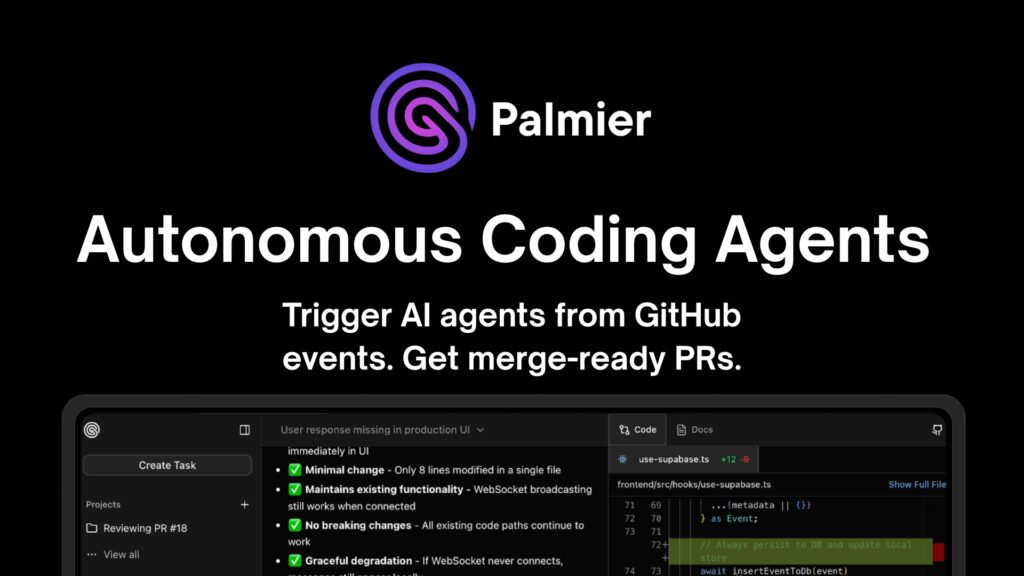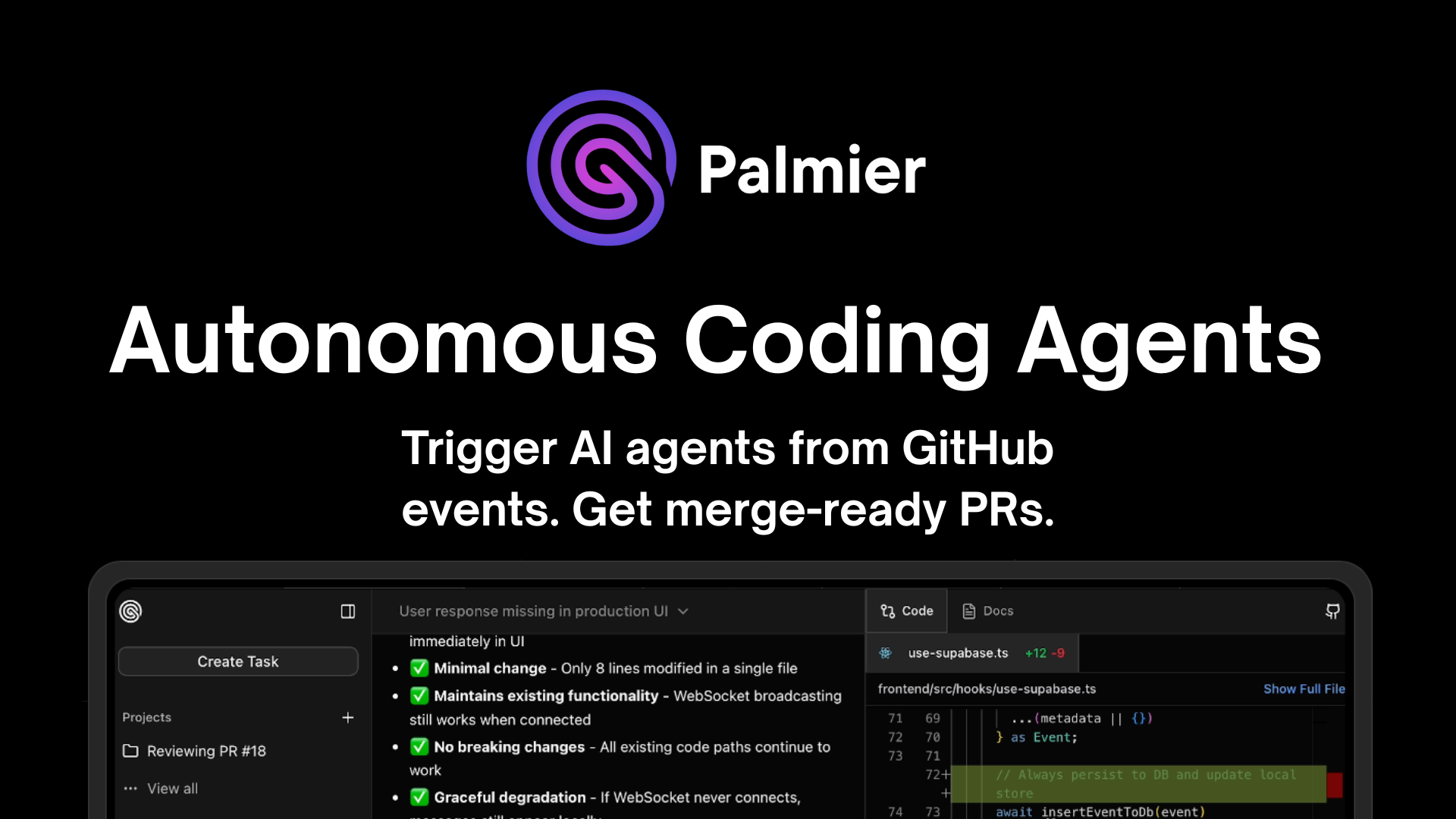AI Native Product Insights – 2025W30

Based on Product Hunt data, we’ve curated a selection of AI Native applications that demonstrate how AI is being built into the core of modern products. These AI Native solutions showcase new developments in functionality and are exploring fresh ways of human-AI interaction. Let’s dive into these AI Native applications.
1. Palmier
Palmier is an autonomous AI coding agent designed to automate core engineering workflows. With deep integration into your development stack, it can write features, fix bugs, triage issues, review PRs, and more — all asynchronously and with full awareness of your codebase context.
📋 More Details
Palmier was created to address the limitations of traditional AI code assistants that still require constant input and guidance. Built by a YC-backed team, it’s designed around real automation via agents triggered by GitHub events or Slack commands. Common use cases include automated PR reviews, CI failure handling, and issue triage — all without developer micromanagement. The result is more productive teams, faster iterations, and significantly reduced manual overhead. The dev community has shown strong interest in Palmier’s agent-based workflow, especially for regaining time and focus.
📊 Evaluation
AI Native Application Modernization: 92/100
Palmier exemplifies an AI-native product: generative AI is not a feature, but the operational core. Its autonomous agent architecture enables proactive task execution, deeply embedded within modern software engineering lifecycles.
🔗 Website
https://www.palmier.io/?ref=producthunt

2. Qwen3-Coder
Qwen3-Coder is an open-source Mixture-of-Experts model tuned for deep agentic reasoning. With 22B active parameters and support for 256K context length, it delivers SOTA performance on complex tasks across coding, reasoning, and mathematics.
📋 More Details
User feedback highlights the exceptional capabilities of Qwen3-235B-A22B-Thinking-2507 within the Qwen3 series. It achieves leading results on key benchmarks like LiveCodeBench and AIME25, rivaling top proprietary models such as Gemini 2.5 Pro. Unlike many high-end models, it’s easy to access via Qwen Chat, eliminating complex deployment barriers.
📊 Evaluation
AI Native Application Modernization: [92/100] This model exemplifies AI-native design, with generative reasoning and agentic capabilities at its core—not as a layer but as the foundation of its architecture.
🔗 Website
https://github.com/QwenLM/Qwen3?ref=producthunt

3. Runway Aleph
Runway Aleph is an AI-native video editing platform powered by an in-context video model. It enables creators to transform videos by adding, removing, or editing objects, modifying lighting and camera angles—all starting from a single input video.
📋 More Details
Community feedback highlights the seamless and creative editing capabilities of Aleph. Users are impressed by the tool’s ability to reshape entire scenes without re-recording footage. The ability to edit style, angle, and lighting dynamically empowers content creators with cinematic flexibility. A major user highlight is the multi-task visual generation from just one source video, showcasing Aleph’s generative AI strength.
📊 Evaluation
AI Native Application Modernization: [92/100] Aleph exemplifies AI-native design, where the generative model is not an add-on but the foundation enabling advanced visual manipulation in context.
🔗 Website
https://runwayml.com/?ref=producthunt

4. Elastic Copilot
Elastic Copilot is an AI-native coding agent for VS Code that autonomously handles end-to-end software development tasks. It can plan and code new features, fix bugs across large codebases, generate documentation, and interact with terminals, browsers, and CI pipelines. Powered by state-of-the-art LLMs including Claude, GPT, and Gemini.
📋 More Details
Elastic Copilot emphasizes full-context development with no token limits, enabled via server-side compute. Architecturally modular and cloud-scalable, it supports multiple models and agentic operations. Real-world showcases like the TrendiGame, built entirely by the agent, demonstrate its full-stack autonomy—handling backend WebSocket logic, multimodal inputs, and UI personalization. Developer tooling includes REST APIs, socket integration, and open infrastructure. While the documentation and community ecosystem are still developing, Elastic Copilot’s deep AI integration, real-time logic execution, and modular stack place it among top-tier AI-native dev tools.
📊 Evaluation
AI Native Application Modernization: [92/100] Elastic Copilot is centered on generative AI from the ground up, serving as an autonomous AI agent rather than a simple assistant—exemplifying high modularity, continuous context integration, and full-stack automation.
🔗 Website
https://elasticapp.io/?ref=producthunt

5. Seed LiveInterpret 2.0
Seed LiveInterpret 2.0 is ByteDance’s latest end-to-end speech-to-speech simultaneous interpretation model. Designed for real-time Chinese-English communication, it combines near-human translation accuracy with an impressively low latency of 2–3 seconds—making it a powerful tool for seamless multilingual interactions.
📋 More Details
Users highlight Seed LiveInterpret 2.0’s standout low latency and voice-cloning capabilities, noting that it replicates not just words, but also the speaker’s voice and tone in the translated output. Built by the ByteDance Seed team, the model is currently accessible via the Volcano Engine API and will soon be integrated into hardware such as the Ola Friend AI headset. While it’s not yet open-source, early adopters predict significant value for real-time global communication use cases. Several users describe it as a leap toward breaking language barriers in live settings.
📊 Evaluation
AI Native Application Modernization: [92/100] Seed LiveInterpret 2.0 is a strong example of AI-native architecture. It uses end-to-end generative AI to power real-time interpretation, with voice replication and latency optimizations that go far beyond traditional AI-enhanced tools.
🔗 Website
https://seed.bytedance.com/en/seed_liveinterpret?ref=producthunt

6. Memories.ai
Memories.ai transforms how we interact with video content. By introducing the world’s first Large Visual Memory Model, it enables users to upload video libraries and query them just like ChatGPT understands and responds to text — offering unparalleled access to video knowledge.
📋 More Details
Early users are impressed by the shift from passive video viewing to interactive exploration. A standout comment notes the ability to *ask* questions directly about a video instead of manually searching through hours of footage — significantly reducing time and improving productivity. This capability positions Memories.ai as a game-changer for professionals working with large media archives.
📊 Evaluation
AI Native Application Modernization: 91/100
Memories.ai is built from the ground up with generative AI as its core. It leverages large-scale multimodal models to understand, index, and retrieve video information semantically — not merely as metadata but as contextual knowledge.
🔗 Website
https://memories.ai/?ref=producthunt

7. Trae 2.0
Trae 2.0 introduces SOLO, an autonomous Context Engineer that handles the entire software development lifecycle—from understanding context to planning, coding, testing, and deploying features. It shifts the paradigm from assistant-based tools to fully generative agents that deliver production-ready code.
📋 More Details
In the launch comments, the team emphasizes that Trae SOLO is not just a chat-based code assistant but a purpose-built AI agent for software creation. Users can choose IDE mode for collaboration or let SOLO take full control in a hands-off build experience. Notably, the team is sharing SOLO’s underlying code on social platforms to encourage experimentation. Feedback highlights excitement about the shift from reactive prompts to AI-led implementation.
📊 Evaluation
AI Native Application Modernization: [91/100] Trae 2.0 is fundamentally AI-native, designing the end-to-end development workflow around generative AI agents. SOLO’s ability to autonomously plan and deliver features positions it as a leading example of modern AI-native applications.
🔗 Website
https://trae.ai/?ref=producthunt

8. Qwen3-235B-A22B-Thinking-2507
Qwen3-235B-A22B-Thinking-2507 is a cutting-edge open-source MoE model optimized for deep reasoning tasks, developed by the Qwen team. With 22B active parameters and support for 256K context length, it sets a new benchmark for complex agentic tasks like code generation and math reasoning.
📋 More Details
Community feedback highlights its exceptional reasoning capabilities, particularly in coding (LiveCodeBench) and mathematics (AIME25). It’s being compared favorably with top-tier models like Gemini-2.5 Pro. Users appreciate the accessibility—the model can be tested immediately through Qwen Chat, without requiring advanced infrastructure.
📊 Evaluation
AI Native Application Modernization: [91/100] This model places generative AI at its core, with a native-first design that excels in structured reasoning and agentic performance. Its architectural foundation is built specifically for high-context, compute-efficient inference, making it a standout AI-native solution.
🔗 Website
https://github.com/QwenLM/Qwen3?ref=producthunt

9. Trickle – Magic Canvas
Trickle Magic Canvas is the first Agentic Canvas platform that lets users visually build full-featured apps and websites alongside generative AI. With a structured and persistent canvas, it replaces text-only interfaces with a modular visual system that supports multi-page design and real-time editing.
📋 More Details
Developed as part of Trickle 2.0, the Agentic Canvas offers a new way to co-create with AI. Unlike standard chat-based generators, it provides a timeline of versions, visual context embedding, and transparent AI actions. Users—from designers to complete beginners—can drag and define components while watching AI-driven progress unfold in real time. Shared projects range from CRM dashboards to cupcake stores, showing the canvas’ adaptability across use cases. Feedback highlights its ability to lower the entry barrier to app creation while maintaining full traceability of AI behavior.
📊 Evaluation
AI Native Application Modernization: 91/100. Trickle is built from the ground up around an AI-core interaction model—context-aware generative AI is integrated into the workflow, not layered on. It transforms code generation into visual collaboration, fundamentally redefining app development.
🔗 Website
https://trickle.so/?ref=producthunt

10. Composer MCP Server
Composer MCP Server enables users to create, backtest, and execute trading strategies directly within Claude using natural language. It supports equities, ETFs, and crypto, offering a fully integrated trading experience without switching platforms.
📋 More Details
According to the team, Composer MCP Server transforms manual, time-consuming quant workflows into a simple conversation with Claude. Users can ask Claude to find high-alpha strategies, run instant backtests, optimize parameters, and even execute trades — all from a single chat interface. Importantly, strategy creation and testing doesn’t require a Composer account, lowering barriers for experimentation. The product reflects Composer’s mission to democratize quant-level trading tools for retail users, giving individuals capabilities previously reserved for hedge funds.
📊 Evaluation
AI Native Application Modernization: 91/100 Claude is at the core of the product experience, not just enhancing but driving the entire strategy lifecycle — from ideation to execution — through natural language. It’s a strong example of AI-native design in trading tech.
🔗 Website
https://www.composer.trade/?utm_source=product+hunt&ref=producthunt

11. DeepDocs
DeepDocs is a GitHub-native AI agent that keeps your READMEs, API references, SDK guides, and tutorials aligned with your codebase — automatically. As your code evolves, documentation is updated without manual effort.
📋 More Details
Built directly into GitHub, DeepDocs continuously monitors code changes to detect outdated documentation. Using LLMs, it understands code semantics and doc context to generate high-fidelity updates that preserve existing writing style and formatting. It supports monorepos, external repositories, and popular frameworks like Docusaurus and MkDocs. Operating like a CI workflow, it proposes pull requests with suggested doc updates, offering developers a GitHub-native experience with minimal friction. While community access and APIs are still limited, its automation, contextual awareness, and modular design represent strong AI-native innovation.
📊 Evaluation
AI Native Application Modernization: [90/100] DeepDocs exemplifies AI-native design by embedding generative AI directly into critical developer workflows. It doesn’t bolt on AI; it’s built around it — leveraging LLMs to understand code and doc relationships, and deploying doc updates like code.
🔗 Website
https://deepdocs.dev/?ref=producthunt

Statement: Evaluation results are generated by AI, lack of data support, reference learning only.